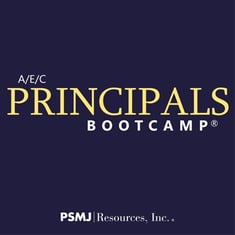 Much has been made of the supposed shortage of leadership skills among engineers, architects, and scientists. There is certainly some truth in that observation. But let’s give leaders in our business credit where credit is due. They have a tough job. After all, they have to try to lead engineers, architects, and scientists!
Much has been made of the supposed shortage of leadership skills among engineers, architects, and scientists. There is certainly some truth in that observation. But let’s give leaders in our business credit where credit is due. They have a tough job. After all, they have to try to lead engineers, architects, and scientists!
Technical professionals—like other professionals—are notorious for their sense of autonomy and resistance to being “managed.” They are usually talented, creative, fiercely competitive, confident, and independent-minded. The very traits that make them effective in their profession can present significant challenges to anyone trying to organize them into a group or team. Consultant Patrick McKenna appropriately characterized this challenge in the title of his book on the subject: Herding Cats.
The result is what borders on anarchy in many professional service firms. This is often most evident among principals, managers, and senior professionals. They may tacitly agree to a new corporate strategy, initiative, or policy, but typically resort back to whatever they’ve grown most comfortable with or what they think is best for them. Thus meaningful change and improvement comes only slowly and grudgingly in such firms.
As a consultant, I am constantly confronted with the complaint “we need more accountability.” This problem seems to be associated with every facet of our operations where improvement is sought, from project management to business development to conducting employee performance appraisals to turning in time sheets on time. So how, as a firm or group leader, can you navigate the transition from anarchy to accountability? It’s not easy, but here are some strategies I’ve found effective over the years:
Seek the consent to lead. The rights of leadership are not assigned by title or management decision. They are voluntarily bestowed by those who will follow. As David Maister observes:
In a professional firm, you can manage only what the professionals will let you manage.
To get anything whatsoever done, professionals must voluntarily approve and accept
new accountabilities ... They must agree to be managed.
This conclusion may turn our conventional ideas of corporate governance on their head, but my experiences (and I presume yours) bear this out. I commonly encounter managers who assume they have the authority to lead, but are afraid to use it. Whether they admit it or not, they instinctively know that such authority doesn’t really exist. So the unspoken standoff persists, and little change happens.
To break the impasse, you need to actively negotiate the terms of leadership with those you are attempting to lead. Outline mutual responsibilities and expectations. Secure “nagging rights” designed to help your colleagues achieve the goals both parties agreed on. Even professionals are willing to be led when they see how it will enable them to succeed.
But establish non-negotiable values and standards. The counterbalance to the negotiated terms is the realization that some things are not open to negotiation. Corporate values cannot be willingly violated by anyone, regardless of his or her stature in the firm. There must be minimum standards of performance, whether related to service, quality, safety, or financial management. Unlawful or unethical behavior cannot be tolerated.
These immutable values and standards are what define the soul of the firm. They also form the foundation of strong leadership. Failing to enforce them to overlook offenses by important firm members or to appease recalcitrant colleagues will not gain their favor over the long run, but only compromise your effectiveness as a leader.
Manage nonbillable time utilization. One of the biggest deterrents to corporate change and improvement is the failure to properly allocate and manage nonbillable time. As a leader, this is a critical resource, both for you personally and for those you lead. If you expect to get much accomplished on any corporate initiative, you will need to secure commitments of nonbillable time from those involved. You will also need to commit an adequate amount of your own time. Don’t leave it to “whenever I find the time.” Budget and track nonbillable time “utilization” on your initiative or activity. Treat that time like you would project time.
Give latitude in the details of implementation. Most seasoned professionals don’t respond well to being told how to do their job. After all, they are the experts. Unfortunately many firms get overly prescriptive in defining how things should be done (while often being vague about the expected outcomes). These firms establish detailed procedures, complicated forms, and exhaustive reporting requirements. When these are ignored, new ones are created.
To break out of this cycle, it’s best to focus on what you want accomplished and let your colleagues determine the details of how to get it done. After you’ve reached mutual agreement on the goals, invite participation in outlining implementation steps. Encourage simplicity, minimize bureaucracy and reporting. Allow for individual variation as long as the desired results are achieved. Then, as noted above, obtain permission to hold folks accountable for doing what they said they would.
Align personal goals with corporate goals. This is a powerful but often overlooked strategy. One of the best ways to motivate people is to help them achieve what they already aspire to do. Look for ways to align individual goals with your firm or team goals. To the extent practical, shape corporate strategy based on what key firm or team members want to achieve personally.
You could argue that this is what essentially happens anyway. Yet rarely have I worked with a firm that intentionally pursued the juncture of personal and corporate initiatives. Goal alignment facilitates the best way to lead: Instead of telling people to “come follow me,” you’re asking “how can I help?”
Build relationships and understanding one-on-one. Group dynamics can be a funny thing, and leaders who attempt to lead primarily in group settings often get false readings about what people are really thinking. It’s best to supplement group sessions with one-on-one conversations to build trust, understanding, and agreement. Ask each individual for his or her suggestions, and how you might help that person be more effective or make things easier. One on one is also the best forum for gaining the “consent to lead” described above.
Give recognition. This common-sense recommendation is unfortunately often neglected. As McKenna and Maister note in their book First Among Equals:
Managers often fall into the trap of looking for problems to be fixed rather than seeing successes
that can be multiplied. This results in everyone being risk averse and cautious. It does little to
encourage the vital task of regularly finding new ways to do the job better.
Everyone craves recognition. This is as true of senior members of your firm as it is of junior staff. So learn to dispense it on a regular basis. Be careful, though, of singling out individuals for what was, in fact, a team effort.
Leverage peer pressure. In the typical professional services firm culture, peer pressure is usually more effective in influencing actions than management directives. For this reason, a team approach is advised. Help the team build a sense of mutual accountability, making commitments to each other and regularly reporting back to the team on their progress. But don’t take it to the extreme of trying to embarrass anyone in front of their peers. That will not only cost you that individual’s voluntary commitment, but likely the team’s as well.
Deal with prima donnas. Every firm seems to have at least one—a principal, key manager, or senior professional who refuses (either openly or passively) to get on board with new corporate initiatives or changes. There’s no denying the value these individuals bring to the firm, but their staunch independence can undermine your best efforts to improve performance. Many leaders simply acquiesce to prima donnas, hoping the momentum of others’ actions will prevail. More likely, however, the double standard ultimately compromises the effort.
Addressing your prima donnas may be your toughest leadership challenge. Begin by approaching the individual privately. Seek agreement on the need for change and ask for suggested strategies that this individual is willing to personally commit to. Remind him or her of the influence wielded in the organization. Often these individuals acknowledge the need for improvement, but feel they are exempted (even though they probably won’t admit it).
If the person continues to resist after you’ve tried appropriate measures to get him or her engaged, then there’s a tough decision to be made. You decide: Which is more important—this individual or your firm’s efforts to grow and improve? A top performer or the values and standards you claim are crucial to the firm’s or team’s success?
Hopefully it doesn’t come to that. But I’ve seen prima donnas hold their firm hostage many times. It’s a crisis of leadership, and your response can be a key differentiator between anarchy or accountability.
About the Author: Mel Lester of BizEdge (www.bizedge.biz) helps engineering, architectural, and environmental firms improve business performance by implementing effective strategies in organizational leadership, business development, client service, and project delivery. He can be reached at 540-268-2300 or mel@bizedge.biz.
 Maintaining strong backlog, sustaining profitability, finding and keeping top talent...just some of the priorities that are top-of-mind with today’s A/E/C firm leaders. Of course, knowing what to do is the first step towards being an effective principal. But, actually doing it is often what separates the “real deal” firm leaders from the others. “Real deal” firm leaders aren’t just born that way. Rather, they develop through proven guidance and experience. They develop by staying close to those who have been there and learning from the seasoned experts. They develop by attending PSMJ’s A/E/C Principals Bootcamp.
Maintaining strong backlog, sustaining profitability, finding and keeping top talent...just some of the priorities that are top-of-mind with today’s A/E/C firm leaders. Of course, knowing what to do is the first step towards being an effective principal. But, actually doing it is often what separates the “real deal” firm leaders from the others. “Real deal” firm leaders aren’t just born that way. Rather, they develop through proven guidance and experience. They develop by staying close to those who have been there and learning from the seasoned experts. They develop by attending PSMJ’s A/E/C Principals Bootcamp.
Your also might be interested in these leadership related blog posts:
Developing the Next Generation of Principals
Expert Interview: Developing Next Generation Leaders
Where Are The Next Generation Leaders?
Are You Doing What it Takes to Build Rapport with Senior Leadership?
8 Must-Haves For Effective Project Leadership
Why Leadership Training is More Important Than You Think


